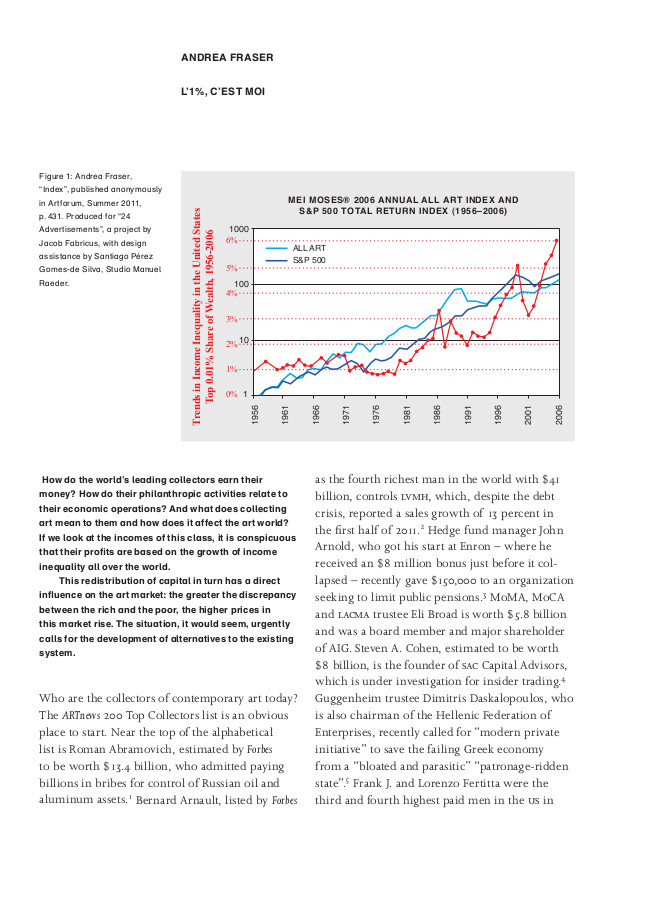Juan A. Gaitán (ed.): The End of Money (2011)
Filed under catalogue | Tags: · art, market, money

This publication accompanies the exhibition The End of Money held at Witte de With center on 22 May – 7 August 2011.
The publication includes texts by Dessislava Dimova, Donatien Grau, Dieter Roelstraete and Carolina Sanín, each contributing to the exhibition’s theme from the point of view of their own medium – be this fiction, art history, philosophy or criticism. Documentation of the exhibition is also included as well as material relating to the works of the participating in the exhibition.
Contributors: Dessislava Dimova, Donatien Grau, Hadley+Maxwell, Peter Fischli and David Weiss, Dieter Roelstraete, Carolina Sanín, and Tonel.
Publisher Witte de With, Center for Contemporary Art Rotterdam, The Netherlands
ISBN 978-90-73362-98-7, 978-90-73362-00-0
146 pages
Andrea Fraser: L’1% C’est Moi (2011–) [EN, ES]
Filed under essay | Tags: · art, contemporary art, institutional critique, market, money

Andrea Fraser’s essay “L’1% C’est Moi” focuses on the direct relationship between art-market trends and income distribution. The essay’s title refers to the statement “l’état, c’est moi” (“the state, it is me“), attributed to Louis XIV and often evoked to illustrate the principle of absolute monarchy, as well as to Gustave Flaubert’s famous remark, “Madame Bovary, c’est moi.”
“How do the world’s leading collectors earn their money? How do their philanthropic activities relate to their economic operations? And what does collecting art mean to them and how does it affect the art world? If we look at the incomes of this class, it is conspicuous that their profits are based on the growth of income inequality all over the world.
This redistribution of capital in turn has a direct influence on the art market: the greater the discrepancy between the rich and the poor, the higher prices in this market rise. The situation, it would seem, urgently calls for the development of alternatives to the existing system.” (from the essay)
First published in Texte zur Kunst 83, Berlin, September 2011, pp. 114-127
7 pages
There’s No Place Like Home, another essay by the author, contribution to Whitney Biennial 2012
Art and Money by William N. Goetzmann, Luc Renneboog, Christophe Spaenjers (2010)
English: PDF, PDF
Spanish: PDF, PDF (trans. 2016, added on 2016-12-18)
Real-World Economics Review, No. 1-59 (2000-2012)
Filed under journal | Tags: · economics, economy, finance, financial crisis, market, money, neuroeconomics, pluralist economics, plutonomy, political economy, post-autistic economics, society
“The movement for Post-Autistic Economics (PAE) was born through the work of Sorbonne economist Bernard Guerrien. The movement is best seen as a forum of different groups critical of the current mainstream: from behavioral and heterodox to feminist, green economics and econo-physics. Started in 2000 by a group of disaffected French economics students, Post-Autistic Economics first reached a wider audience in June 2000 after an interview in Le Monde.
It was supported by the Cambridge Ph.D. students in 2001 with the publication of ‘Opening Up Economics: A Proposal By Cambridge Students’, later signed by 797 economists.
PAE has challenged standard neoclassical assumptions and incorporated ideas from sociology and psychology into economic analysis. Specifically, the notions of utility theory, rational choice, production and efficiency theory (Pareto optimality), and game theory have been criticised.
Other topics include ‘Gross National Happiness’, realism vs. mathematical consistency, ‘Thermodynamics and Economics’, or ‘Irrelevance and Ideology’. Contributors include Bruce Caldwell, James K. Galbraith, Robert L. Heilbroner, Bernard Guerrien, Emmanuelle Benicourt, Ha-Joon Chang, Herman Daly and Richard D. Wolff.
In March 2008 the Post-Autistic Economics Review changed its name to the Real-World Economics Review.” (from Wikipedia)
Editor: Edward Fullbrook
Associate Editor: Jamie Morgan
Open-access journal
ISSN 1755-9472
wikipedia (Post-autistic economics)
authors (RWER blog)
publisher
PDF (Issue 59, March 2012)
PDF (Issue 58, December 2011)
PDF (PDF papers, all past issues)

